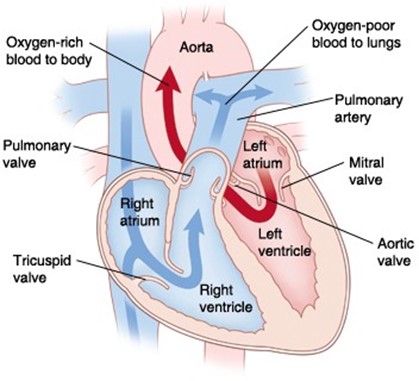Which of the following is the correct sequence of parts through which blood moves from the vena cava to the lungs?
Right atrium, tricuspid valve, right ventricle, pulmonary valve.
Right ventricle, pulmonary valve, right atrium, tricuspid valve.
Right atrium, pulmonary valve, right ventricle, tricuspid valve.
Right ventricle, tricuspid valve, right atrium, pulmonary valve.
The Correct Answer is A

This is the correct sequence of parts through which blood moves from the vena cava to the lungs.
Choice B is wrong because it reverses the order of the right atrium and right ventricle. Blood flows from the right atrium to the right ventricle, not the other way around.
Choice C is wrong because it switches the positions of the tricuspid valve and the pulmonary valve.
Blood flows from the right atrium through the tricuspid valve to the right ventricle, and then through the pulmonary valve to the pulmonary artery.
Choice D is wrong because it also switches the positions of the tricuspid valve and the pulmonary valve, and reverses the order of the right atrium and right ventricle.
Blood flows from the right atrium through the tricuspid valve to the right ventricle, and then through the pulmonary valve to the pulmonary artery.
The normal range of blood pressure in the vena cava is about 0 to 5 mmHg, while in the pulmonary artery, it is about 15 to 25 mmHg.
The normal range of oxygen saturation in the vena cava is about 60% to 80%, while in the pulmonary vein, it is about 95% to 100%.
Nursing Test Bank
Naxlex Comprehensive Predictor Exams
Related Questions
Correct Answer is B
Explanation
As a result of the allergen-antibody reaction, mast cells release histamine.
This is because when mast cells are exposed to an allergen that binds to IgE antibodies attached to their FcɛRI receptors, they release histamine and other inflammatory mediators.
Histamine causes vasodilation, increased capillary permeability, mucus secretion, and smooth muscle contraction, which result in allergic symptoms such as itching, swelling, sneezing, and wheezing.
Mast cells do release histamine in response to allergen-antibody reactions. Some additional sentences are:
Normal ranges of histamine levels vary depending on the tissue and the method of measurement, but they are usually low in healthy individuals and elevated in allergic conditions.
Histamine can be degraded by enzymes such as diamine oxidase and histamine N- methyltransferase, or inhibited by drugs such as antihistamines.
Correct Answer is C
Explanation

This is because lymph enters the lymph nodes from the collecting ducts, where it is filtered and monitored by immune cells.
From the lymph nodes, lymph travels through larger vessels called lymphatic trunks, which eventually drain into the bloodstream.
Choice A is wrong because veins are blood vessels that carry blood back to the heart, not lymph.
Plasma is the liquid part of blood that contains proteins and other substances.
Choice B is wrong because capillaries are the smallest blood vessels that exchange materials between blood and tissues, not lymph.
Blood supply is the delivery of blood to organs and tissues.
Choice D is wrong because arteries are blood vessels that carry blood away from the heart, not lymph.
Serum is the liquid part of blood that remains after clotting.
Whether you are a student looking to ace your exams or a practicing nurse seeking to enhance your expertise , our nursing education contents will empower you with the confidence and competence to make a difference in the lives of patients and become a respected leader in the healthcare field.
Visit Naxlex, invest in your future and unlock endless possibilities with our unparalleled nursing education contents today
Report Wrong Answer on the Current Question
Do you disagree with the answer? If yes, what is your expected answer? Explain.
Kindly be descriptive with the issue you are facing.
